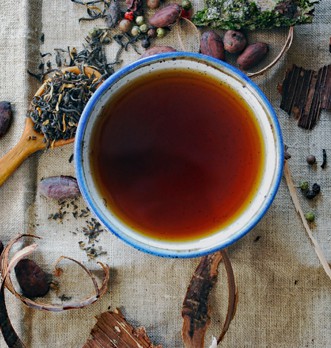
Black tea is not a variety of tea. All teas come from the same shrub, the tea plant (camilla sinensis). They are all named after the same phenomenon: oxidation. Although we hear a lot about fermentation, it is a misnomer and black tea is oxidized through a very specific process.
Oxidation (or fermentation) of black tea
There are two methods of making black tea. The orthodox process, which takes its time and requires several steps to obtain a quality black tea. This method is often found in China and India, and is better for the taste, but also for the health, these are the teas you should choose.
The CTC method consists in optimizing the production. This can result in black teas of varying quality, so be careful about the origin of the tea and choose teas from well-known provinces such as Yunnan, Keemun, etc.
Oxidation of black tea: classic method
The traditional process for making black tea involves several steps (just like for other teas).
Withering
Just after the harvest, the tea leaves are dried until their moisture content is reduced by half. The leaves are spread out on grids and air is blown in at a temperature of 25 degrees. The leaves are of course turned over and stirred regularly. This step takes about 24 hours.
The rolling of the tea leaves
Here, the tea leaves are "rolled" in order to extract the essential oils. If this operation is now performed by a machine, some great teas are still rolled by hand. These are teas of very high quality.
Oxidation
This is the most important and controlled step, from withering to rolling. Oxidation occurs when the polyphenols come into contact with the air. It is the same phenomenon as for apples or avocados. These polyphenols are usually protected by vacuoles, except when there is a "break". Chlorophyll also undergoes a transformation, changing the pigmentation of the tea leaves. The more oxidized a tea is, the darker it will be.
Fixation of the oxidation
Last step of the process, the fixation consists in stopping the oxidation. The method is simple. We expose the tea leaves to a heat source, more or less long. Once the oxidation is stopped, the black tea is packed and ready to be consumed as a drink.
The CTC
Crush-Tear-Curl is a method that aims to reduce production time. The black tea produced by this method is generally of lower quality than that produced by conventional processing and is often used for tea bags. The cost of this method is much lower and allows the use of damaged tea leaves.
Name of the teas
In China, black tea is called red tea, because of the coppery color of the water during infusion. This can lead to confusion with rooibos, which comes from another plant and is not a tea, but an infusion.
They may also call it fermented tea, which is a mistake. In fact, black, white or green teas have the same preparation. It is the oxidation steps and their duration that change depending on what you want to obtain. Only yellow tea is fermented. For example, Pu-Erh is a yellow tea with a taste that changes with time.
Another case of confusion is Oolong. Despite its color after infusion (the Chinese also call it raven tea), it is not a black tea. Its oxidation is between green and black tea. It is also less rich in theine.
Black tea is mostly consumed in the West. Its culture is practiced in many countries, nevertheless, it is mainly intended for importation. The English are the ones who drink it the most.